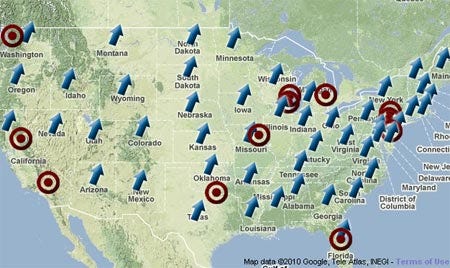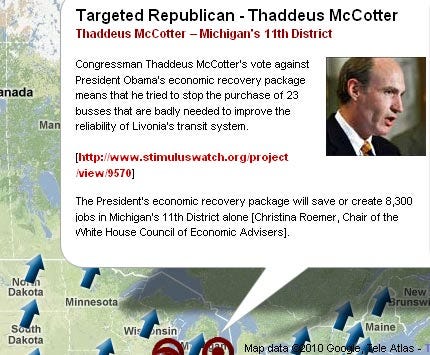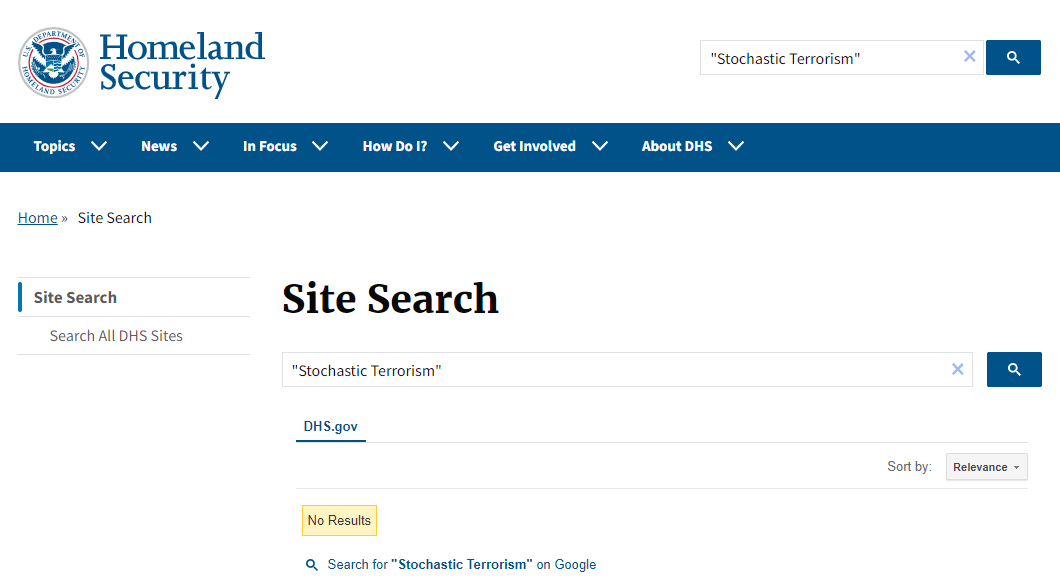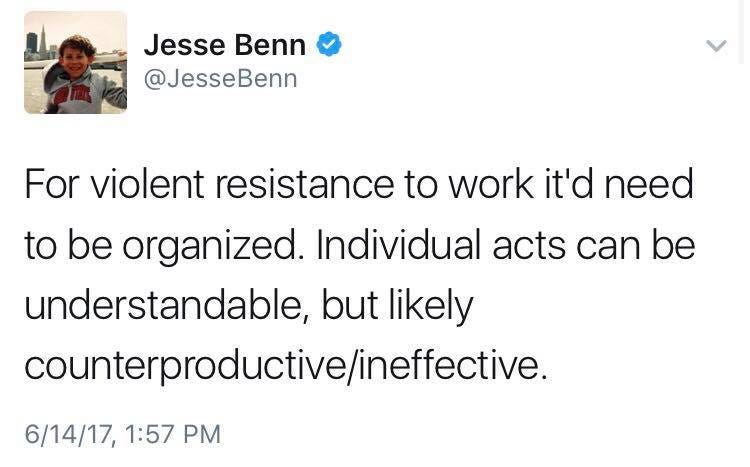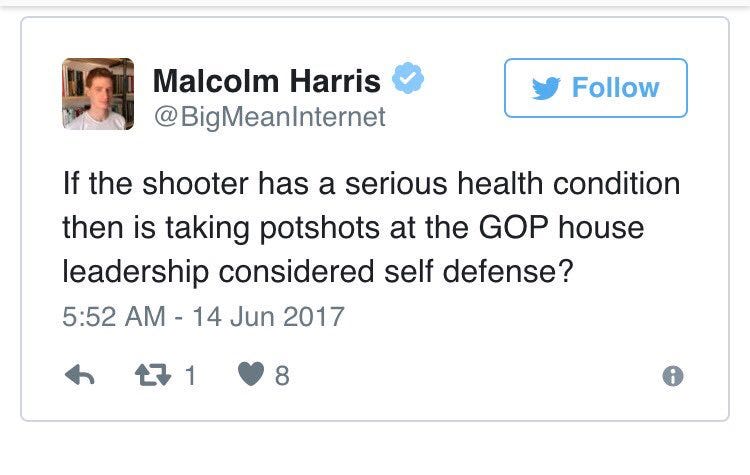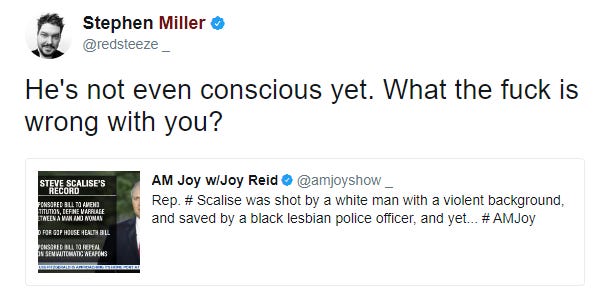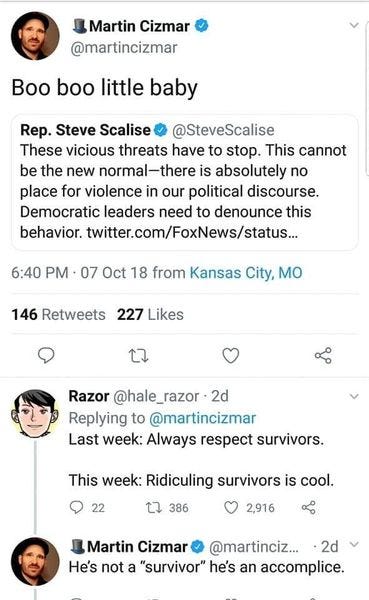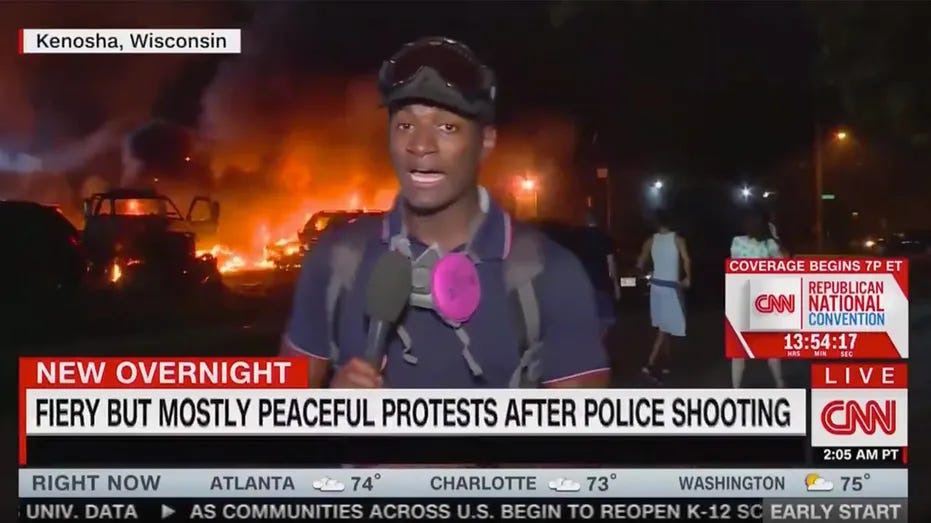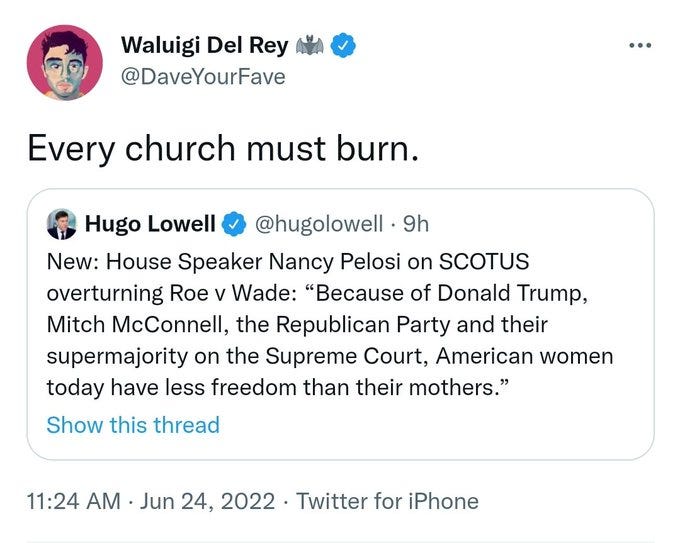Stochastic Terrorism - A game of rhetorical asymmetry
The history and function of the increasingly common phrase explained
On January 8, 2011 in Tuscon, Arizona, 19 people were shot and six people were killed by a man named Jared Loughner. A Congresswoman from Arizona, Gabby Giffords, was shot in the head. Giffords was Loughner’s primary target. The Congresswoman was in critical condition and was placed into an induced coma, and was fortunately among the survivors.
Despite Loughner being immediately arrested, many had concluded that there was an accessory to the attempted assassination who remained at large: Former Governor of Alaska and Vice Presidential candidate Sarah Palin.
Markos Moulitsas is the founder of the blog/newsite the DailyKos, once one of the most influential political websites in the US.
Although the link in Moulitsas’ tweet is no longer functional, The Internet Archive has a copy of the page he was originally linking to.
[Emphasis in original]
Sarah Palin’s Hit List
By: TBogg Saturday January 8, 2011 11:07 am[…]
Fuck it. I’m going there…
Back in September:
Twenty House Dems from districts that McCain carried in 2008 voted for the health care bill, and Sarah Palin has a target on every single one.
The targets were released on the six month anniversary of Obamacare, and include a lot of familiar names such as John Boccieri (OH), Chris Carney (P N) Gabrielle Giffords (AZ) and Ann Kirpatrick (AZ).
Gawker, another once influential website, often thought of as a “gossip rag” published “Shot Congresswoman Was In Sarah Palin's 'Crosshairs'“ on the same day.
Gabrielle Giffords, The Arizona congresswoman shot today outside a Tucson Safeway, was featured on Sarah Palin's infamous 'crosshairs' map, which targeted legislators who voted for Obama's health care bill. Remember? The map that was criticized as an incitement to violence?
“Rep. Gabrielle Giffords' blood is on Sarah Palin's hands after putting cross hair over district” - NY Daily News
Palin would no doubt say that she was only speaking in metaphor, that she only meant her followers should work to unseat Giffords and 19 other Democrats who had roused her ire by voting for health care.
But anyone with any sense at all knows that violent language can incite actual violence, that metaphor can incite murder. At the very least, Palin added to a climate of violence.
When the accusations of Sarah Palin’s ultimate responsibility for the events started to gain steam, Pailin’s Political Action Committee team issued a rebuttal.
Were they really ‘crosshairs’?
The first rebuttal to the accusation that Palin was ultimately responsible, was that they weren’t gun-sight crosshairs, they were symbols used by surveyors to mark locations on a map, the kind you would find in any CAD System.
The symbols are indeed quite commonly used in conjunction with maps, as similar symbols are included in GPS icon packages as well.
This argument, however, lead to a very stupid discussion about whether or not they were truly surveyor’s symbols or if they were gun-sights.
“What a Crooked Cross Sarah Palin Bears” - Esquire
Well, Sarah Palin has serious chutzpah: Her operation is now scolding Americans for suggesting that the use of gunsight-like "surveyors marks" on her infamous map of "targeted" Democrats, which included Gabrielle Giffords, could be interpreted as encouraging gun violence.
[…]
Briefly, a point of fact: There is no such thing as a standard set of surveyors marks. They change state-to-state, company-to-company and even surveyor-to-surveyor.
[…]
But there is a larger point to be made. Palin's camp was evidently prepared for the moment when they'd come under attack for using gunsights, and were ready with the surveyors-mark explanation.
“Palin Aide: Symbols Weren't Rifle Sights, but Surveyor's Marks” - The Atlantic
Sarah Palin new media aide Rebecca Mansour sought to deflect attention from an electoral map Palin posted on her Facebook page last March in an appearance on Tammy Bruce's radio show Saturday. The images long described as crosshairs or rifle sights were actually just surveyor's symbols, Mansour said.
“Palin Spox: Targets on SarahPAC Map Were Actually ‘Surveyor’s Symbols’” - Slate
Among the people who gave the impression that these were targets: Sarah Palin. When she announced the list in a tweet, she wrote “don’t retreat, instead - RELOAD!” I’m not an expert surveyor, but I’m not sure what sort of tools need reloading.
Fortunately, the mind-numbingly stupid conversation about whether they were really gun-sights quickly fell to the wayside. It became obvious that Palin’s PAC map was not a wholly original construction, and is a template that has been used before without controversy.
The Democratic Leadership Council had put out a similar map with the objectionable language “targeting" regions, and used bullseyes, which of course suggest a goal of sending a projectile into the absolute center. “Behind enemy lines” likewise suggests one is in a shooting war of some kind.
The Democratic Congressional Campaign Committee had used a similar template just a year prior to the Gifford’s shooting, and also specifically named politicians as “targets”
While the accusation that Palin was ultimately responsible was strong in some heavily partisan circles, the specifics were failing to stick in the broader narrative. Even the cast of The View pointed out that ‘crosshairs’ are used in popular media, over real people, regularly, without people assuming the subject will wind up shot.
On Good Morning America two days later, Palin’s culpability for inspiring the shooting was muted by reports Loughner had been obsessing over Giffords since 2007 with no evidence he had seen the map or any of the other items within Palin’s political circumference.
Those who wished to pin the ultimate responsibility of this shooting on Sarah Palin were also thwarted by the eventual understanding that Loughner was a paranoid schizophrenic, and wholly disassociated from reality. Subsequent to the shooting Loughner’s YouTube videos made in the months and weeks prior began to be discovered and the less than grounded reality of Loughner became too much to overlook.
For the most part, the accusation didn’t quite stick. While to this day many still blame Sarah Palin for the shooting of Gabby Giffords, it doesn’t succeed in getting much traction.
On June 14, 2017 the New York Times’ Editorial board published “America’s Lethal Politics” [emphasis mine]
In 2011, when Jared Lee Loughner opened fire in a supermarket parking lot, grievously wounding Representative Gabby Giffords and killing six people, including a 9-year-old girl, the link to political incitement was clear. Before the shooting, Sarah Palin’s political action committee circulated a map of targeted electoral districts that put Ms. Giffords and 19 other Democrats under stylized cross hairs.
Other outlets jumped in to correct the New York Times.
“The bogus claim that a map of crosshairs by Sarah Palin’s PAC incited Rep. Gabby Giffords’s [sic] shooting” - Washington Post, June 15, 2017
“A political map circulated by Sarah Palin’s PAC incited Rep. Gabby Giffords’ shooting” - Politifact, June 14, 2017
The New York Times was then forced to modify their editorial and add “But in that case no connection to the shooting was ever established.” after the above excerpted sentences. Sarah Palin sued the New York Times for libel over the editorial.
Stochastic Terrorism: the game begins
The first appearance of anything remotely resembling the phrase “Stochastic Terrorism” can be found in a 2002 paper by Gordon Woo, titled “Quantitative Terrorism Risk Assessment” published in the Journal of Risk Finance. The article was about the insurance market trying to factor in the cost of acts of terrorism that are measured to occur at a certain rate over time into their policies.
From the abstract
Traditionally, terrorism risk has been priced based exclusively on the relationship between supply and demand in the insurance market, with no basis in actuarial principles. This article discusses how the tragic events of September 11, 2001, have irrevocably changed the market for terrorism insurance, since terrorism has become a U.S. catastrophe risk. The author states that since insurers seek to quantify risk distributed over several months (versus a period of only a few days), quantitative assessment of terrorism risk may be achievable.
But the phrase “Stochastic Terrorism,” as it is being used today was actually first coined by an anonymous blogger, ‘G2geek’, on the progressive site the dailykos, the same dailykos owned by Markos Moulitsas, on Monday January 10, 2011, in response to the Giffords shooting.
Stochastic terrorism is the use of mass communications to stir up random lone wolves to carry out violent or terrorist acts that are statistically predictable but individually unpredictable.
This is what occurs when Bin Laden releases a video that stirs random extremists halfway around the globe to commit a bombing or shooting.
This is also the term for what Beck, O'Reilly, Hannity, and others do. And this is what led directly and predictably to a number of cases of ideologically-motivated murder similar to the Tucson shootings.
The first appearance of the phrase anywhere in the news was in the letters to the editor on page 16 of The Columbian Thursday, January 27, 2011.
Michael T. Carver of Ridgefield referenced the definition as being from “epluribusmedia.net.” The reference is a blog post written on January 13th, 2011 which itself was referencing the DailyKos
A Look at "Stochastic Terrorism: Triggering the Shooters" (from DailyKos)
Submitted by MichaelCollins on January 13, 2011"The stochastic terrorist is the person who uses mass media to broadcast memes that incite unstable people to commit violent acts." G2geek, January 10, 2011
Daily Kos diarist G2geek published an essay on January 10 that deserves attention and further analysis. He argued that rash media figures activate lone wolf types through "emotional rhetoric."
Correcting the ultimate flaw
The ultimate flaw in accusing Sarah Palin of being responsible for the shooting of Gabby Giffords was that concrete details were provided to support it. When concrete details are provided, they are able to be held up to scrutiny.
By focusing on specific actions of Sarah Palin, whether by proxy through her political action committee releasing the target map, or her tweets using gun analogies for political battles, the fact that the shooter was not only disconnected from their influence but disconnected from reality overall interrupts that narrative.
But the term “Stochastic Terrorism” eliminates this problem. Someone can be ‘guilty’ of “Stochastic Terrorism” without any attacks even occurring.
So, what is ‘Stochastic Terrorism’?
Stochastic Terrorism is a truly clever piece of rhetoric that one can admire for its pure propagandistic potency.
The concept itself is certainly coherent. In almost any population of sufficient size, there will be people — commonly considered “crazy” or at least considered “unhinged” — who get caught up in political emotions in a way that is more extreme than the average citizen, and are set on a course that ultimately results in them committing violent acts.
This possibility is not often predictable in specifics (e.g. ‘Mark Stouffers’ will shoot ‘Debbie Brownstone’ on June 12th) but predictable in the sense that someday, someone, will commit some act. This randomness, the inability to know when, who, or what will be involved but knowing eventually something will, is the ‘stochastic’ part of Stochastic Terrorism.
If one assumes people motivated to carry out an attack are not attacking purely at random (that is, attacking just anybody who happens to be nearby at the time), they will attack with targets in mind. That suggests someone with broad reach can count on somebody listening to them can be activated like a Manchurian Candidate and that Manchurian Candidate will focus on the targets the Stochastic Terrorist wants.
The lack of direct call for violence is then framed as being strategic — it creates plausible deniability. The Stochastic Terrorist gets “the best of both worlds.” They get to “mathematically” rely on their targets being the victims of an attack with no record to be found of them ever actually asking anyone to do so.
By labeling someone as a Stochastic Terrorist you can influence others to associate some of the most immoral and violent acts imaginable with the person being labeled regardless if any violent acts have occurred.
The first move in the game
Stochastic Terrorism is also a truly clever piece of rhetoric because it creates the illusion of sophistication and rigor. “Stochastic” is not a common word except in the world of probability and statistics (and fields that heavily rely on them). Nobody goes to their grocery store, bumps into an old friend from middle-school they haven’t seen in decades, and says “it’s quite stochastic that I bumped into you today!”
The phrase sounds to the average person as being very academic. Only very intelligent and erudite individuals must discuss complex subject matter such as Stochastic Terrorism. Taking control of this idea is the first part of the game.
While the term can obviously have meaning, it is just a term that popped into existence because someone recently made it up in order to accuse Sarah Palin of being responsible for the shooting of Gabby Giffords. And since it is constructed to appear academic, people can claim to be experts who study it.
You know that you didn’t spend years studying it, but that’s all you could know.
Anyone who claims to be an expert on the subject becomes an expert by fiat. You, perhaps not generally inclined to being a liar, don’t consider the prospect of just asserting yourself an expert of this newly minted term. But someone who does simply declare themselves an expert now has the ability to decide for the public who is, and who is not, a Stochastic Terrorist.





“Attacks on the LGBTQ+ Community Amount to Stochastic Terrorism” - The Advocate
The U.S. has seen increased violence in recent years, and a specific path has emerged. It begins with poisonous rhetoric that inspires individuals and groups to engage in violent behavior. It's called stochastic terrorism, and it's a big problem online.
The danger with this violence is extreme because it is inspired by politicians and media personalities who aren't held accountable.
[…]
As a Harvard Kennedy School professor, [Juliette] Kayyem is a global leader in crisis management and homeland security. She served as assistant secretary for intergovernmental affairs at the Department of Homeland Security under President Barack Obama and as homeland security adviser to Deval Patrick when he was governor of Massachusetts. She is one of the most renowned experts on stochastic terrorism.
Oh wow! One of the most renowned experts on Stochastic Terrorism! That’s quite impressive. Let’s head on over to the Department of Homeland Security and review some of the material on Stochastic Terrorism to learn more from this expert.
Oh well, so much for that. Let’s try looking at news articles between 2011 and 2016. Just to see what Juliette’s expertise had to contribute
Interesting. Either Juliette decided to talk repeatedly about “Stochastic Terrorism” with respect to the LGBTQ+ community when Worldcrunch was writing about topics such as IKEA photoshopping women out of images, the Syrian Civil War, and China’s relationships in South East Asia, or a single article, written in Worldcrunch on August 25 2022, is appearing on those pages as links and being cached by google and generating hits between 2011 and 2016.
By making the first move and establishing yourself as an expert on Stochastic Terrorism you create a very important asymmetry in the game. You get to set the perception of who the Stochastic Terrorists are.
The second move
Because the term does have a relatively easy to grasp concept, sounds academic and authoritative, and has serious experts who study it, people will copy and spread the idea.






Now that the term has been established into peoples minds as an academic and well-studied concept, the experts can help navigate and “call out” the Stochastic Terrorists. Notorious Stochastic Terrorists such as the author of the Harry Potter series.



The ‘Stochastic’ part of Stochastic Terrorism is a benefit to the experts. Because, as is essential to the idea, violence can be expected “stochastically,” they can rest assured something will occur eventually. The more they assert certain people are Stochastic Terrorists, the more those people are immediately to blame the moment any incident occurs, no matter if the violence was related to them in any way or not.
The term has completely corrected for the the original flaw in accusing Sarah Palin of being responsible for the shooting of Gabby Giffords. No details are necessary.
The third move
Because experts are pointing out examples and beginning to “explain” properties and nuances of Stochastic Terrorism, eventually those on the “side” being accused of Stochastic Terrorism will use the criteria too.
The point of the game is to establish and maintain rhetorical asymmetry, though. It is not to establish the idea of Stochastic Terrorism and hold all people up to new, higher, standards. Therefore a robust set of responses must become instinctive to those wishing to maintain control over the Stochastic Terrorism claim.
Be brazen in your hypocrisy
On June 14, 2017, James Hodgkinson travelled from his home in Illinois to Eugene Simpson Stadium Park in Alexandria, Virginia and opened fire on 24 Republican congressmen who were practicing for the annual congressional baseball game.
Firing over 50 rounds, while there were several injuries (some severe), nobody but the shooter died that day. Congressman Steve Scalise had been shot in the hip, the bullet fracturing his pelvis and caused severe internal bleeding. Scalise was in critical condition for three days and underwent several surgeries and had several blood transfusions to help account for the loss of blood.
Hodgkinson, from the best that can be gathered, was not a paranoid schizophrenic. He was apparently someone with a history of acts of domestic violence, however. He would possibly fall under the “unhinged” category and not necessarily “crazy,” as one might feel free to call Jared Loughner.
Hodgkinson was supporter of Bernie Sanders and even was a volunteer for Sanders’ presidential campaign.
Hodgkinson’s own descriptions on social media portray him as an avid consumer of political shows. His favorite television shows were listed as “Real Time with Bill Maher;” “The Rachel Maddow Show;” “Democracy Now!” and other left-leaning programs.
His favorite movie? The documentary “Inequality for All,” featuring progressive economist Robert Reich.
He had also joined several anti-GOP Facebook groups, including “Terminate The Republican Party;” “The Road to Hell Is Paved With Republicans;” and “Join The Resistance Worldwide!!”
Hodgkinson was very animated by Health Care debates. Just before the shooting, on May 4th, 2017, SFGate, the “digital home” of San Francisco Chronicle, published a widely read editorial “All the ways Republicans want you dead”
“Republicans want you dead” is a popular mantra. It’s a rallying cry any time Republicans do not vote the way some would wish (which is almost always).
Given all the expertise and study of Stochastic Terrorism that is out there, one would expect it to be seen that language claiming “Republicans want you dead” suggests those “targeted” by Republicans are entitled to take action in self-defense. When your life is threatened, you are often morally and sometimes legally permitted to use deadly force to “neutralize” the threat. Language suggesting the need for violent means of self defense would be a form of Stochastic Terrorism and the experts would recommend a tamping down of the language. Like in the aftermath of the Giffords’ shooting, we would be focusing on rhetoric to see what might have driven Hodgkinson to attempt mass assassination of Republicans.
But that’s of course not what occurred - because making sure there is nothing but asymmetry is the goal. The ‘experts’ can stay silent if they wish and allow others to make the assassination attempt seem like a reasonable act.
Consider Jesse Benn, a writer for the Huffington Post, and his reaction to the shooting.
It was inadvisable tactically, but not morally.
Similarly, on MSNBC, Joy Reid, instead of discussing the rhetoric surrounding the shooting that may have contributed to the so very widely understood and studied phenomenon of Stochastic Terrorism, aired a segment discussing the ways in which Steve Scalise was an appropriate target. While he was still in critical condition.




Just two weeks before the shooting, comedienne Kathy Griffin released some new photos from a recent photoshoot she did, where she held the bloody severed head of Donald Trump.
Two days before the shooting, New York City’s Public Theater did a “Shakespeare in the park” production of Julius Caesar. For this production, Julius Caesar was made to resemble Donald Trump. This Donald Trump as Caesar was, as the play goes, killed.
Because the game is one of establishing and maintaining asymmetry, not only was there a lack of analysis of Stochastic Terrorism from the experts who are so very concerned about the phenomenon — but five days after the shooting, while MSNBC was discussing Scalise’s appropriateness as a target, Vox published an article explaining why anyone taking issue with the choice of making Julius Caesar be Donald Trump was just too sensitive and didn’t get the play.
The uproar all stems from one key creative decision: namely, portraying Julius Caesar as Donald Trump.
Even before the production officially debuted, Julius Caesar was drawn into the perpetual outrage machine that powers modern American political media. Right-wing outlets such as Breitbart and Fox News expressed horror over the Public Theater’s particular staging of the play, in which a blond, coiffed politician who resembles the US president — he tweets from a golden bathtub and wears a red tie, and his wife has a Slavic accent — is assassinated in Act III beneath an American flag, by a cast that contains women and minorities.
None of the experts who are so very concerned about the subject they have studied for years, Stochastic Terrorism, made any comments of the subject after the attempted assassination of over a dozen Republican congressmen. Certainly never discussed Kathy Griffin’s severed head photo has possibly having any relationship to the climate that Stochastic Terrorism operates under. Nor did they discuss the Shakespeare in the Park production. In fact, a google news search only returns three results for Stochastic Terrorism for that time period. And it’s because the 2022 LGTBQ+ articles by Wordcrunch and The Advocate are cached as a linked articles.
Have your counter moves ready to go
Acts of violence, as the central premise of Stochastic Terrorism goes, will occur from time to time. While the asymmetric game is being played for multiple rounds, the people routinely on “the side” of those being accused of Stochastic Terrorism will notice that symmetric circumstances are ignored, downplayed, or defended.
Noticing the asymmetry makes people inclined to mention it when the time arises. When an act of violence occurs and the experts are on to talk about Stochastic Terrorism again to reinforce the asymmetry, it will be mentioned how they were silent during an earlier situation - like the Republican baseball shooting.
In order to prevent that from reducing the asymmetry, a rhetorical tactic is employed that is to declare whataboutism. This brilliant little nugget of rhetoric has been instilled in the populace as a perfect countermeasure to maintain dominance in the asymmetric game.
From wikipedia:
Whataboutism or whataboutery (as in "what about…?") denotes in a pejorative sense a procedure in which a critical question or argument is not answered or discussed, but retorted with a critical counter-question which expresses a counter-accusation.
Merriam-Webster explains it a little more clearly
The tactic behind whataboutism has been around for a long time. Rhetoricians generally consider it to be a form of tu quoque, which means "you too" in Latin and involves charging your accuser with whatever it is you've just been accused of rather than refuting the truth of the accusation made against you. Tu quoque is considered to be a logical fallacy, because whether or not the original accuser is likewise guilty of an offense has no bearing on the truth value of the original accusation.
The dictionary gives those playing the asymmetric game a perfect rhetorical weapon to use while protecting the asymmetry. When their asymmetry is challenged — that is, when its pointed out they are not applying the same standards to all cases — they are able to claim you, the person on “the side” of the Stochastic Terrorists, are the one engaged in rhetorical games. “Why can’t we focus on the situation at hand (which maintains the asymmetry) and not be distracted by events of the past?”
Rinse, repeat
With the game established by the first movers, and the asymmetry protected, participants on the side with the rhetorical power can simply continue to lean in —solidifying the asymmetry.
During the Supreme Court nomination process for Brett Kavanaugh, many on “the left” were convinced that Brett Kavanaugh was a violent serial rapist. Someone who, in their eyes, was not only was guilty of sexually assaulting a woman named Christine Blasey Ford in college, but was actually someone who was part of an organized group of individuals who would drug women and take turns gang raping them while passed out.
These allegations were primarily spearheaded by former attorney Michael Avenatti, who a short time after would wind up pleading guilty to five criminal charges in exchange for dropping 31 additional criminal charges. Rachel Maddow on MSNBC was more than willing to simply air the scandalous allegations with very little scrutiny.
The allegations caused a national uproar, with Senators claiming to have received what may easily be interpreted as violent threats.
In the wake of his vote to confirm Supreme Court Justice Brett Kavanaugh on Saturday, Republican Sen. Cory Gardner, R-Colo., revealed to Fox News on Sunday that his wife had received a graphic text message with a video depicting a beheading, and that someone has publicly posted the names and addresses of his family members.
Gardner announced his support for Kavanaugh in July, and reaffirmed it after reviewing the supplemental FBI report into uncorroborated sexual misconduct allegations against him.
As I’m sure you would be able to guess by now, everyone was very concerned about Stochastic Terrorism and took extra precaution to not fuel the fire.
Just a few months later, a High School student named Nicholas Sandmann was caught on camera having a face. This event, being photographed having a face, understandably caused another national uproar on par with the accusations of Supreme Court nominee Brett Kavanaugh serially drugging and gang-raping women.
Honest question. Have you ever seen a more punchable face than this kid’s?
This honest question was tweeted by Reza Aslan, in response to the photograph. Twitter, being so concerned about Stochastic Terrorism that they say targeting someone with harassment is against their Terms of Service, immediately responded to the tweet by waiting a year and letting Aslan delete it on his own because he was facing a possible lawsuit.
Others were far more reserved in their reaction, given the circumstances.
Rinse, repeat, again
Poker is a game of luck and strategy. Poker players spend a lot of time analyzing games, trying to get a sense of probabilities to play their hands wisely. Games are often a marathon, not a race. Patience can pay off.
When a player allows emotions to overcome them, this patience can evaporate, and the player will begin to make strategic error after strategic error. This is called being on tilt.
Tilt is a poker term for a state of mental or emotional confusion or frustration in which a player adopts a suboptimal strategy, usually resulting in the player becoming overly aggressive. Tilting is closely associated with another poker term, "steam".
Placing an opponent on tilt or dealing with being on tilt oneself is an important aspect of poker. It is a relatively frequent occurrence due to frustration, animosity against other players, or simply bad luck.
Maintaining this asymmetry and employing tactics like ignoring instances of Stochastic Terrorism and then declaring someone is playing “whataboutism” when they notice has the bonus of possibly putting the other side on tilt.
In order to increase the chance of putting the other side on tilt, the degree to which the idea of Stochastic Terrorism is flouted in their face must also increase.
Just like the old expression that some people view a glass as half full while others view it as half empty, Stochastic Terrorism can simply be ignored by reframing instances of major violence in context to the universe surrounding them. Instead of instances of violence being the end results of Stochastic Terrorism, the universe is incorporated into the analysis to declare the events mostly peaceful.
After the viral footage of the death of George Floyd at the hands of police, social media and establishment media immediately excitedly reported new police altercations as being examples of corrupt police, and all police actions possibly racist in nature. Riots became a regular event.
Describing riots as “mostly peaceful” allows for the rhetorical negation of any accusations of Stochastic Terrorism, and allows for the continued excited elevation of every police encounter as being corrupted by racism.
Dismissal maintains asymmetry and might have an added bonus of pushing the other side on tilt.
When a draft leak of a Supreme Court opinion striking down Roe v Wade surfaced, people posted the addresses of Supreme Court Justices’ homes. Instead of expressing concerns about rhetoric and posting of addresses being Stochastic Terrorism, the White House Press Secretary, Jen Psaki said she was ok with the protests being at the Justice's homes but wanted them to be peaceful. The increased probability someone could try to commit an act of violence towards a Supreme Court Justice was not factored in — the random nature explicit in Stochastic Terrorism was a shield for Psaki because for now violence is just a hypothetical.
Someone did, ultimately, use these addresses to go to Brett Kavanaugh’s house with the intent of assassinating him. He had also contemplated assassinating others.
When the ruling finally came down, candidates for instances of Stochastic Terrorism increased precipitously.
Despite good reason to believe these tweets violate Twitter’s Terms of Service, Twitter has not removed them.

Also, despite a man already being arrested for intending to assassinate Brett Kavanaugh, the renowned expert on Stochastic Terrorism, mentioned concern zero times.
In the same time period, “pregnancy centers,” which are “pro-life” alternatives to Planned Parenthood, were being burned down or vandalized. Here again, the possible randomness of which center to burn down and when was contrasted to the universe, and the concept of Stochastic Terrorism disappeared and an accusation that being concerned about the arsons was just people being, I guess, too sensitive.


Here we see again that the randomness and lone-wolf nature of "Jane’s Revenge” is used as an argument that those complaining are blowing things out of proportion by being concerned. The discussion of Stochastic Terrorism is nowhere to be found. After all, there’s no central organization coordinating these arsons, so there’s nothing anyone can do about them.
The term is here to stay
Because of how rhetorically effective the term Stochastic Terrorism is — it is a very useful weapon to wield in political discourse — it is going to stick around. Only very recently have there been efforts by some in academic or homeland security circles to take the concept and use it in a more official capacity.
On June 14th 2022 Kurt Braddock, Assistant Professor of Public Communication at American University, gave testimony as part of a House Hearing on Extremism and Preventing Domestic Terrorism, having more recently received a grant of $568,000 from the “Targeted Violence and Terrorism Prevention Grant Program” from DHS.
Some of the testimony could serve a crude summary of this article.
Rep. Dan Bishop: One thing you said in your testimony and I saw it in the written testimony as well, is that you credit DHS for its program here for the use of, quote, measures of program effectiveness, close quote. And you say that's kind of rare in the field. And then you say, quote, Because of this, the field is rife with pundits posing as professionals, close quote
[…]
Rep Bishop: I guess I’ll keep using that term, it’s hard to say Stochastic.
Kurt Braddock: It’s annoying, yeah. It’s a statistics term that I didn’t come up with. I think the term Stochastic Terrorist, I think it emerged somewhere around 2011/2012? I actually had a discussion with someone earlier, I just did a podcast, where I said I don’t actually like the term Stochastic Terrorism because terrorism is an activity.
In 2017, in the book “The Age of Lone Wolf Terrorism” Mark Hamm, a criminologist at Indiana State University and Ramon Spaaij, a sociologist at Victoria University mention Stochastic Terrorism in chapter 5 “The Enablers.”
They provide a surface definition of the concept, and provide two cases to illustrate the idea. The first was a 2010 shootout that involved a man named Byron Williams.
His mother recalled that Williams spent most of his time at home researching online information about the “shadow government” and watching Fox News, and she noted that her son was upset by “the way Congress was railroading through all these left-wing agenda items.” In response, Williams later told investigators, he wanted to “start a revolution by traveling to San Francisco and killing people of importance at the Tides Foundation and the ACLU.”
Williams targeted Tides because he believed that American billionaire philanthropist George Soros was controlling the Tides Foundation and using it “for all kinds of nefarious activities,” including making a financial killing on Wall Street by betting on the Deepwater Horizon disaster. In a press interview, Williams cited Fox News commentator Glenn Beck as the primary source for his information on the liberal conspiracy to benefit from the oil spill.
By Glenn Beck having a large audience and declaring that certain people and organizations are causing harm in major ways, there is an increased probability someone might get the idea to take action against people and organizations they mention. Stochastic Terrorism.
The other example is from 2012, an attack at the Family Research Council headquarters.
At 11 a.m. on August 15, 2012, twenty-eight-year-old Floyd Corkins entered the Washington, DC, headquarters of the Family Research Council, a conservative Christian lobbying group, and told a receptionist that he was interviewing for an internship. 8 After approaching an unarmed security guard and being asked for identification, Corkins said: “I don’t like your politics.” He grabbed a 9mm semi-automatic pistol from his back-pack and fired three shots at the guard, striking him once in the arm. The guard rushed Corkins and with others wrestled the gun away from him and pinned him to the floor. A 911 call was made and within minutes police arrived along with FBI agents and hauled the shooter away.
[..]
Upon questioning by the FBI, Corkins said he was a gay rights activist and that he had intended to commit mass murder at the Family Research Council (FRC). When agents searched his backpack, they found a box of 9mm ammunition and fifteen sandwiches from a Chick-fil-A restaurant. Corkins said that he was a volunteer at a local LGBT community center. When asked how he chose his target, Corkins replied: “Southern Poverty Law, lists . . . uh . . . anti-gay groups. I found them online.”
The Southern Poverty Law Center, which Corkins was referring to, is an activist organization that presents itself as being dedicated to “countering extremism.” By having a large audience and declaring that certain people and organizations are causing harm in major ways, there is an increased probability someone might get the idea to take action against people and organizations they mention. Stochastic Terrorism.
The concept of Stochastic Terrorism has only recently had a very small handful of people making an attempt at an academic review. Despite that, its rhetorical utility will ensure that it will be treated as a long existing and well-understood phenomenon with a chosen supply of “experts” at the ready to bludgeon political opposition.
So the term is here to say. Just try to be aware of the game that’s being played.












